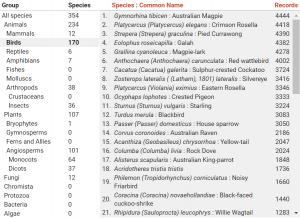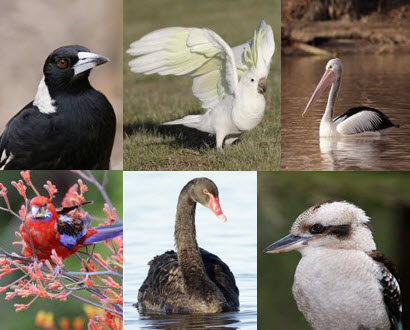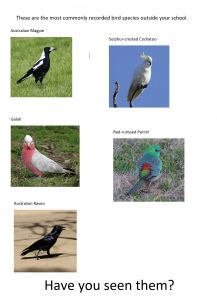The following classroom activities for Foundation to Year 2 guide you through some suggested discussions with students, with activities branching off from the discussion. Just completing the discussion and ALA demonstration alone addresses some curriculum requirements. You can amend any of the activities or discussion questions to suit your particular area or students needs.
Before you begin
- Use the Atlas of Living Australia to see which birds have been recorded in the area surrounding your school. For instructions showing how to do this, see User Guide 1 – Finding the species located in your area.

- For the following discussion and activities, choose six of the birds listed near your school that you think students would be familiar with, or you could use the familiar common birds shown below.

- You might like to set up a poster of birds around your school like the one below.

Discussion with students
Show the students images from the ALA of the birds chosen. The following questions could begin the discussion with students. To find more information and to view more images of each bird, see User Guide 6 – Finding information about a species.
- Does anyone know what any of these birds are? Have you seen one of them before? Do you remember where you saw it? Would you see all of these birds in the same place? Does anyone know any facts about any of the birds? Do you know what any of these birds eat? Do you think any of these birds would visit the school yard? Why/ why not?
- Out of the chosen birds, do any have similar beaks? Out of the chosen birds, which one grows the biggest? Out of these birds, which ones have some black feathers?
- What sound does each bird make? (If one is available, play them the sounds from the ALA website. You may find other sound clips elsewhere).
At this point, or at any point following, any of the Activities 1-6 could be completed by the students. These can be modified in any way to suit your local area.
Head outside
- Walk around the school yard and look for birds. Ask students to write down any birds they see. If they don’t know the names, write size, shape, colour, where they saw it, maybe draw it. You may like to send the students out in smaller groups to different areas of the school yard.
- If possible, take some photos of birds in the school yard. (If you like, you can log the sightings on the ALA via iNaturalist Australia. See User Guide 4 – How to log a sighting. You can then view the sightings you have made when you zoom in to your school area on the map.)
- Record the birds you saw in a table. Activity 8 is a table students could use to record their findings.
- Students could also complete Activity 7 to report on the birds that were found in the school yard.
Further discussion
- Did we see any of the birds in the school yard that were on our list of 6? Did we hear any of the birds from our list? Based on what we know about the birds on our list, would we expect to see them in the schoolyard? Why/ why not? Did we see any other birds? Does anyone know what those birds are called? Was there more of one type of bird than others? Were there any differences in the birds seen by different groups?
- Did we see no birds at all? If not, why not? What are some ideas about what we could do next time to make sure we see some? Were there any birds we did not recognise? If there were some we didn’t recognise, where might you go to find out what it was? Some ideas can be found here.
- Do you think if we went outside at a different time of day that we would see different birds? (Try that. Compare the list from the first visit to this list. Are there any differences? Why/ why not? Did we find what we expected?) What about at a different time of year?
- Who might find our observations useful?
Available activities: